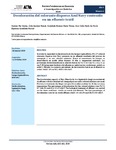| dc.contributor.author | Osornio Paz, Karina |
| dc.contributor.author | Ávila Jiménez, Miguel |
| dc.contributor.author | Castañeda Briones, María Teresa |
| dc.contributor.author | Cruz Colín, María del Rocío |
| dc.contributor.author | Espinoza-Castañeda, Marisol |
| dc.date.issued | 2020 |
| dc.identifier.citation | Osornio-Paz, K., Ávila-Jiménez, M., Castañeda-Briones, M.T., Cruz-Colín, M.R. & Espinoza-Castañeda, M. (2020). Decoloración del colorante disperso Azul Navy contenido en un efluente textil. Revista Tendencias en Docencia e Investigación en Química, 6(6), 642-646. http://hdl.handle.net/11191/7776 |
| dc.identifier.uri | http://hdl.handle.net/11191/7776 |
| dc.description.abstract | Se evaluó la capacidad de decoloración de dos hongos ligninolíticos; M1 y F sobre el colorante disperso Azul Navy presente en un efluente resultante del proceso de estampado y en una solución colorante. Previo al tratamiento, los hongos se desarrollaron en medio salino durante 15 días a temperatura ambiente. Los porcentajes de decoloración en la solución fueron de 75.7 ± 5.7 con M1 y 42.2 ± 2.2 con F. El tratamiento biológico del efluente se realizó en tres condiciones: estéril, no estéril y filtrado. Los mejores porcentajes de decoloración fueron en el efluente no estéril; 46.6 ± 1.9 con M1 y 35.0 ± 3.0 con F. |
| dc.description.abstract | The discoloration capacity of Navy Blue dye by two ligninolytic fungi was evaluated. An effluent with dye obtained of a stamped process and a colored solution were used. Previous to treatment, the fungi were growth in saline medium for 15 days at room temperature. The percentages of discoloration for the colored solution were 75.7 ± 5.7 with M1 and 42.2 ± 2.2 with F. The biological treatment of effluent was carried out for three conditions: sterile, no sterile and filtrated. The best percentages of discoloration were for no sterile effluent; 46.6 ± 1.9 with M1 and 35.0 ± 3.0 with F. |
| dc.format | pdf |
| dc.language.iso | spa |
| dc.publisher | Universidad Autónoma Metropolitana (México). Unidad Azcapotzalco. División de Ciencias Básicas e Ingeniería. |
| dc.relation.ispartof | https://revistatediq.azc.uam.mx/Docs/Revista_TeDIQ_2020.pdf |
| dc.source | Revista Tendencias en Docencia e Investigación en Química. Año 6, número 6 (enero-diciembre de 2020). ISSN: 2448-6663 |
| dc.subject | Biodecoloración, hongos ligninolíticos, azul navy. Biodiscoloration, ligninolytic fungi, navy blue. |
| dc.subject.classification | BIOLOGÍA Y QUÍMICA::CIENCIAS DE LA VIDA::MICROBIOLOGÍA::MICROBIOLOGÍA INDUSTRIAL |
| dc.title | Decoloración del colorante disperso Azul Navy contenido en un efluente textil |
| dc.type | Artículo |
| dc.format.digitalOrigin | Born digital |



